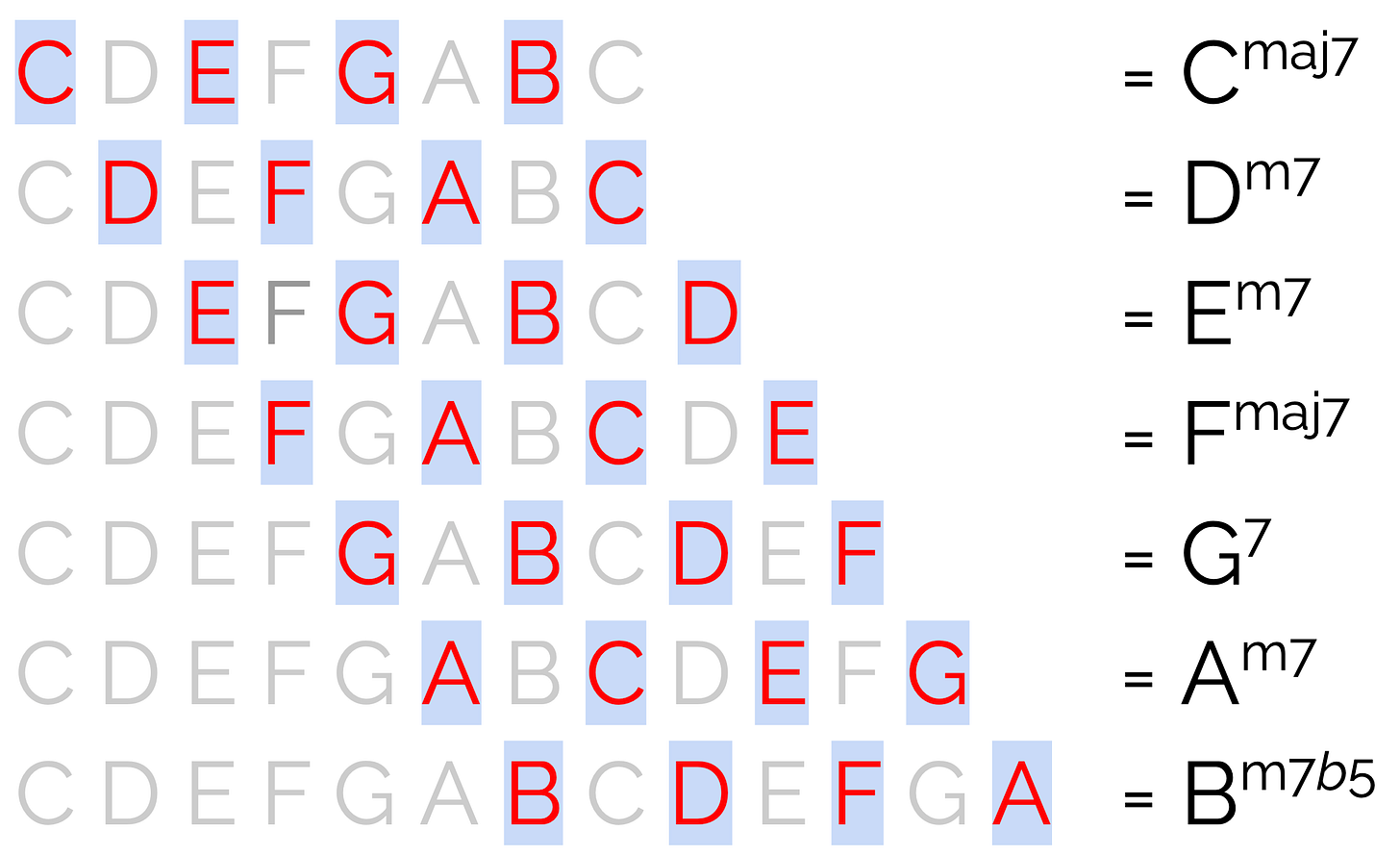In Part One, we gave names to the sections of songs—verse, chorus, etc
In Part Two, we talked about our musical ruler of time: beats & bars.
Here in part 3, we’ll look at our musical ruler for pitch: the major scale
👉 Oh, and don’t forget to check out RhythmOS.
📏 The other musical ruler
You know the major scale:
You could describe it:
with words,
with a formula,
with letter names, or
with a fretboard shape.
But most importantly, you know what it sounds like.
It’s the basis of all western music… even when it’s not.
Wait, what?
Yeah, that’s right:
Even when we’re not using the major scale, we still describe things as they relate to the major scale.
The major scale is our ruler for pitch.
For example, here’s a C major scale on guitar:
Notice those numbers. These are “scale degrees” or “intervallic functions.”
They’re a measuring stick. We’re measuring how far we are from the root.
Now check out this C minor scale:
Notice how the scale degree numbers call out their relation to the major scale:
♭3 = “flat three” = one fret lower than the 3 in the major scale
♭6 = “flat six” = one fret lower than the 6 in the major scale
♭7 = “flat seven” = one fret lower than the 7 in the major scale
We’ll come back to this, but for now…
Letters instead of numbers
You can also describe a major scale with note names: C, E♭, F♯, etc.
We’ll use C major because it doesn’t have any “accidentals”—no ♯s or ♭s:
C D E F G A B C
On your guitar, you might play it like this:
Notice that the “CDEFGABC” happens twice: CDEFGABCDEFGABC.
Each of those CDEFGABCs is an “octave”…
…which makes this a two-octave C major scale.
That extra octave will come in handy when we…
Stack up every other note
That’s how we build basic chords:
These are the “diatonic triads” in the key of C.
diatonic = only uses notes from the key
(ie no outside notes)
triad = chord with three distinct notes
(open position chords have redundant notes)
These chords show up in the same order in every key
We chose C because it let us sidestep ♯s & ♭s.
But no matter what key we’re in, the chords naturally occur in this order:
is major
is minor
is minor
is major
is major
is minor
is diminished
Sorted by chord type:
1, 4, & 5 are major
2, 3, & 6 are minor
7 is an oddball (and we can safely ignore it indefinitely)
You don’t have to memorize that chart
Sure, it’s handy for transposing.
But even before that, it helps us group chords together into their key:
The A, E, F#m, D of Wagon Wheel? → that’s I-V-vi-IV in the key of A
The F to G in Fleetwood Mac’s Dreams? → that’s IV to V in the key of C
You ever get a new car, then start to notice that car everywhere? Same deal here.
Once you start paying attention to which chords appear together, you’ll begin to develop an intuitive grasp of what key a song is in.
Spicier (but still diatonic)
We can also build fancy chords… while staying within the key.
For our diatonic triads, we stacked up every other note for three notes.
To build our diatonic 7 chords, we simply stack one more note:
Just like with the triads, these chords appear in this order every time:
is a “major seven” (maj7)
is a “minor seven” (m7)
is a “minor seven” (m7)
is a “major seven” (maj7)
is a “dominant seven” (7)
is a “minor seven” (m7)
is a “minor seven flat five” (m7♭5)
These distinct chord flavors can be great context clues. For example, there’s only one “dominant 7” chord per key (here in the key of C it’s G7). So if I see a G7, my mind starts to think “C major.”
But be careful; thar be dragons there.
Reality is messy
Of course, real songs break this neat, tidy model.
Real songs have chords & notes that are “non-diatonic”—they use notes from outside the key. That’s totally ok!
Remember, there’s only one rule in music: if it sounds good, it is good.
In the next lesson, we’ll look at some examples. We’ll explore unusual chords and unusual chord progressions.
If you’re not already subscribed, now would be a great time to do so:
That’s all I got this week.
See you next Wednesday,
Josh
ps. Check out the missing manual for guitar’s most important skill.













Just want to say your Rhythm OS course is truly brilliant. The musical examples are so perfectly chosen and elevate the class to a level above anything else I've used. I am hoping one day your full guitar OS course is released!